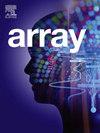Machine learning models to predict desktop activity recognition based on low-point gaze features
IF 4.5
Q2 COMPUTER SCIENCE, THEORY & METHODS
引用次数: 0
Abstract
Eye-tracking desktop activity prediction analyzes how users behave and think through their eye movements for the purpose of behavior prediction during computer use. The study examines how low-point gaze features functioning alongside machine learning (ML) models enable predictions of eight frequent desktop activities which are Debug, Browse, Play, Read, Interpret, Search, Watch and Write. The research uses simple gaze metrics obtained from 24 users through the Tobii X2-30 eye tracker for fixation count analysis along with saccade direction and gaze point statistics in order to support scalable non-intrusive deployment. The research utilized over 200,000 samples from which statistical analytics data was derived along with spatial-temporal eye movement characteristics through preprocessing. Eight well-known ML algorithms including Logistic Regression, Decision Tree and Random Forest, Neural Network and Gradient Boosting, AdaBoost, Naive Bayes and K-Nearest Neighbors received training and evaluation through 80/20 train-test split divisions. Each model conducted testing for activities through the computation of accuracy and precision and recall and F1-score metrics. Results from the evaluations show that Neural Networks coupled with Random Forests produce the best results through average performance metrics which surpass 0.91. The sustained focus activities such as Play, Read, Interpret, Watch and Write responded best to NN while RF demonstrated its strength during tasks of task-switching and problem-solving particularly in Debug and Search activities. The presented study proves the possibility of achieving accurate eye-tracking activity prediction through lightweight gaze features alongside conventional machine learning models. This investigation brings the possibility of creating real-time dynamic interfaces and user-based systems and diagnostic assessments in both consumer and clinical applications. Future research will investigate combining different models with optimization techniques to boost robustness performance in user-variable conditions and dynamic operational settings.
基于低点凝视特征预测桌面活动识别的机器学习模型
眼动追踪桌面活动预测分析用户在电脑使用过程中的行为和思考方式,以达到预测用户行为的目的。该研究考察了低点凝视功能如何与机器学习(ML)模型一起工作,从而能够预测八种常见的桌面活动,即调试、浏览、播放、阅读、解释、搜索、观察和写入。该研究使用Tobii X2-30眼动仪从24名用户获得的简单凝视指标进行注视计数分析,以及扫视方向和凝视点统计,以支持可扩展的非侵入式部署。本研究利用了20多万份样本,通过预处理获得了统计分析数据和眼动时空特征。逻辑回归、决策树和随机森林、神经网络和梯度增强、AdaBoost、朴素贝叶斯和k近邻等8种著名的机器学习算法通过80/20训练测试分割进行训练和评估。每个模型通过计算正确率、精密度、召回率和f1得分指标对活动进行测试。评价结果表明,神经网络与随机森林相结合,平均性能指标超过0.91,效果最好。持续焦点活动如Play、Read、Interpret、Watch和Write对NN反应最好,而RF在任务切换和解决问题的任务中表现出优势,特别是在Debug和Search活动中。该研究证明了通过轻量级凝视特征和传统机器学习模型实现准确眼球追踪活动预测的可能性。这项研究带来了在消费者和临床应用中创建实时动态界面和基于用户的系统和诊断评估的可能性。未来的研究将探讨将不同的模型与优化技术相结合,以提高在用户可变条件和动态操作设置下的鲁棒性性能。
本文章由计算机程序翻译,如有差异,请以英文原文为准。
求助全文
约1分钟内获得全文
求助全文

 求助内容:
求助内容: 应助结果提醒方式:
应助结果提醒方式:


